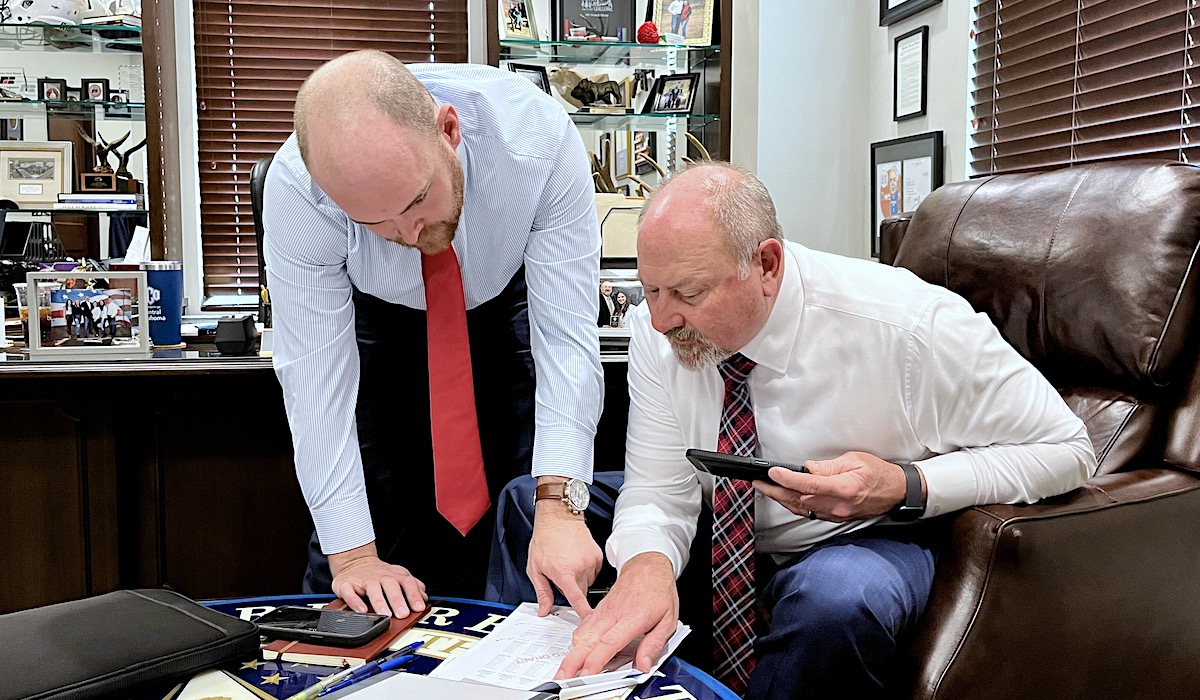
Despite hopes that today’s Oklahoma Board of Equalization meeting would put state leaders on the same page about revenue estimates and appropriation possibilities, not even a dozen pages of financial figures in 10-point font could form a clear fiscal picture in what could become another tumultuous legislative session.
While today’s final revenue projections yielded a roughly $83 million higher appropriation authority than was estimated in December, legislative negotiations about Oklahoma’s FY 2025 budget remain in the starting blocks, with House and Senate leaders having different interpretations of how much new recurring revenue could be used for state investments and possible tax cuts.
“After the certification of these numbers, we’ll be around $337 million (additional recurring revenue over last year) or something like that,” Senate Appropriations and Budget Chairman Roger Thompson (R-Okemah) said immediately after Thursday’s meeting.
House Appropriations and Budget Chairman Kevin Wallace (R-Wellston) had a slightly different interpretation an hour later.
“The BOE number says it’s definitely more than $337 million,” Wallace said. “We’ve got to get on the same page, and we’ve got to get in the same room to do that, sooner rather than later.”
Thompson said he “totally agreed” that the chambers still have to find common figures from which to start their work.
Informed that the House and Senate have different interpretations of Thursday’s spreadsheets, Gov. Kevin Stitt furrowed his brow before laughing.
“Isn’t it funny we can’t even agree on math in this building?” Stitt asked.
Moments earlier, Stitt had chaired the Board of Equalization meeting, which breezed along until a series of questions from Attorney General Gentner Drummond about income tax estimates, comments from Oklahoma Tax Commission leaders and clarifications from Wallace about how costs related to school-choice tax credits will likely climb $50 million annually over the next two years.
Ultimately, Drummond cast the lone vote against certifying Thursday’s financial predictions.
“The attorney general’s vote is a reflection of his lack of confidence in certain revenue estimates that were provided,” said Phil Bacharach, Drummond’s communications director.
Wallace echoed some of those concerns, although he and other legislative leaders acknowledged that conservative revenue estimates are better than having predictions fall short.
“There are questions, doubts or concerns of the accuracy of the numbers for the BOE,” Wallace said. “For the last three to four sessions, the estimates seem to me to be very conservative on expected revenues. The word or term that was used by [the Tax Commission] the other day was, we’re giving you a ‘soft’ forecast. Historically, the revenue has been coming in way above the estimates when we’ve closed the books.”
‘Working together and agreeing on basic math’

With Thursday’s numerical uncertainty forecasting high drama ahead, the two chairmen of the chambers’ budget committees are expected to meet for the first time soon, but new dynamics and old battle scars underscore the complex conversations ahead.
Stitt, McCall and Senate President Pro Tempore Greg Treat are embarking on their sixth year as the decision-making triumvirate in the Oklahoma State Capitol. But while both McCall and Treat are serving their final year in the Legislature owing to term limits, they have articulated different goals and different preferences for the potential of tax cuts. Stitt, meanwhile, has pledged to sign any tax reduction sent to his desk.
Now, with today’s final revenue projections drawing questions about accuracy and higher appropriation authority than estimated in December, legislative negotiations about Oklahoma’s Fiscal Year 2025 budget can begin more earnestly between the House and Senate — to the extent the parties want to ramp up the proverbial treadmill.
For the 2024 regular session, senators have set forth on a new procedural direction featuring deeper financial dialogue that will be punctuated by a Senate resolution providing their negotiation position and, they claim, unprecedented transparency in a building often defined by opaque actions.
In doing so, however, House leaders have expressed frustration with a lack of early-session meetings between budget committee chairmen and overall uncertainty about how — and when — negotiations will be structured.
“If the Senate likes their new process, that’s great. In terms of transparency, it’s not transparent to the House because there’s not been any conversations between the Senate and the House about their process or what’s moving through their process,” House Speaker Charles McCall (R-Atoka) said Thursday morning. “There’s going to continue to be more of a process than just what’s taking place in the Senate.”
Stitt said he was “pretty pleased” with the fiscal picture painted at Thursday’s Board of Equalization meeting, but he acknowledged lingering concerns about how and when his office will be included in the House and Senate song and dance.
“Most Oklahomans out there just going about their daily business, they expect us to be working together and agreeing on basic math,” Stitt said. “Politics gets in the way sometimes because this chamber might want to do something different, or they’ve got a program they want. (…) But sure, we should be talking about these things. We should be having some honest conversations.”
Stitt pointed to Thursday’s revised revenue projections as further evidence that it’s time for tax cuts, either in the form of a 0.25 percent reduction in personal income tax rates — which carries a $250 million annualized cost — or the elimination of the state portion of sales tax on groceries, which carries a $400 million price tag.
“Our economy is just super strong. Oklahomans are resilient, our business community is great, unemployment is low, we’ve got a huge energy advantage here. Oklahoma is the place to be, and companies are realizing that all over the country,” Stitt said after Thursday’s meeting. “Fortunately, we’ve got continued revenue increase, and that’s a good thing. But I do think we need to be very cautious. We can’t just keep spending. We need to give tax cuts back to the taxpayer.”
‘I do remember 2014 when the bottom went out’

On the topic of tax cuts, McCall and Wallace have favored the income tax reduction, while Treat reiterated Thursday that he prefers the grocery tax elimination.
“With these numbers and the current savings we have, now is the time to cut the grocery tax. Cutting the grocery tax will give Oklahomans immediate relief every time they leave the grocery store and will be more beneficial than any other form of tax cut,” said Treat (R-OKC) in a statement.
Thompson has expressed even more caution than Treat about the risk of cutting taxes to the point of reviving revenue problems faced by legislators during the wretched sessions of 2016, 2017 and 2018, which culminated with a significant tax hike to fill budget holes and provide teacher pay raises.
Although Drummond was not in elected office a decade ago, he referenced lean times during Thursday’s meeting.
“I do remember 2014 when the bottom went out,” Drummond said.
In Oklahoma, the state constitution requires either public approval of revenue-raising measures or 75 percent support from both the House and Senate. While Treat, McCall, Wallace and Thompson all leaped through the revenue-raising obstacle course in 2017 and 2018, dozens of current legislators did not.
“They’ve come in where there’s a lot of money. They didn’t live through all those long days of trying to raise money with a 75 percent vote because we couldn’t pay our bills,” Thompson said days before Thursday’s Board of Equalization meeting. “They weren’t here whenever we were down to $2 in a savings account, so they didn’t have to make those hard decisions. They didn’t understand it.”
Thompson said the personal and corporate income tax cuts approved two years ago by lawmakers are only now being realized, and a pair of smaller tax cuts passed last year still haven’t reached their maximum impact.
Thompson said the Senate’s new budget process will be “transformational,” with all members and the public being able to see the upper chamber’s appropriation proposals and consider long-term impacts.
“I believe this process is bigger than any one person, and we’ve got our members more engaged in the budget than they have been since I’ve been here. [Each] subcommittee knows their numbers. They know what their liabilities are going to be behind the numbers, and they’re having to make tough choices,” Thompson said.
Wallace, however, has expressed confusion over the idea that he and Thompson won’t begin face-to-face negotiations until March at the earliest.
“I’m not frustrated. I just keep saying the House is going to continue to run the budget process the way it’s always been done, open and transparent,” Wallace said. “Sometimes there is a technique in sports where, if you think you’re ahead you try to run the clock out. I will say the Senate has used that before thinking that if they stall until the very end people will cave to their position. But that’s not the best thing for the state of Oklahoma, and it’s not going to happen.”
Thompson said he intends to meet with Wallace soon to find commonality in the starting numbers. He also said Senate subcommittee chairpersons have been encouraged to converse — not negotiate — with their House counterparts about major policy proposals that carry a price tag.
“The illustration that I read a while back that I’m using is, ‘You don’t learn to drive a car by sitting in the parking lot,'” Thompson said. “So we’re going to drive this car, and there are going to be some bumps in the road, and hopefully there are no major accidents. But we are going to learn to drive as we go public with the budget and open discussions everywhere.”
Wallace said he’s ready to put his truck into gear.
“It feels a lot later in session than the fourth day of the second week,” Wallace said. “There’s a lot of work going on. I mean, I’ve been extremely busy — multiple meetings on major policy issues and not a moment’s break.”
Board of Equalization packet – FY 2025 revenue estimate





















